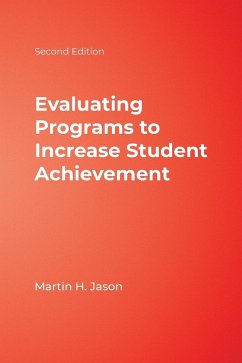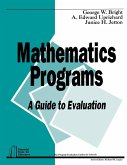Martin H. Jason
Evaluating Programs to Increase Student Achievement
Schade – dieser Artikel ist leider ausverkauft. Sobald wir wissen, ob und wann der Artikel wieder verfügbar ist, informieren wir Sie an dieser Stelle.
Martin H. Jason
Evaluating Programs to Increase Student Achievement
- Gebundenes Buch
- Merkliste
- Auf die Merkliste
- Bewerten Bewerten
- Teilen
- Produkt teilen
- Produkterinnerung
- Produkterinnerung
This updated edition on evaluating the effectiveness of school programs provides an expanded needs-assessment section, additional methods for data analysis, and tools for communicating program results.
Andere Kunden interessierten sich auch für
![Mathematics Programs Mathematics Programs]() George W. BrightMathematics Programs31,99 €
George W. BrightMathematics Programs31,99 €![Designing and Developing Programs for Gifted Students Designing and Developing Programs for Gifted Students]() Joan Franklin SmutnyDesigning and Developing Programs for Gifted Students34,99 €
Joan Franklin SmutnyDesigning and Developing Programs for Gifted Students34,99 €![Discovering Programs for Talent Development Discovering Programs for Talent Development]() Beverly N. ParkeDiscovering Programs for Talent Development36,99 €
Beverly N. ParkeDiscovering Programs for Talent Development36,99 €![Identification of Students for Gifted and Talented Programs Identification of Students for Gifted and Talented Programs]() Joseph S. RenzulliIdentification of Students for Gifted and Talented Programs35,99 €
Joseph S. RenzulliIdentification of Students for Gifted and Talented Programs35,99 €![Reading and Language Arts Programs Reading and Language Arts Programs]() Mary W. OlsonReading and Language Arts Programs26,99 €
Mary W. OlsonReading and Language Arts Programs26,99 €![Curriculum Development for Gifted Education Programs Curriculum Development for Gifted Education Programs]() Curriculum Development for Gifted Education Programs160,99 €
Curriculum Development for Gifted Education Programs160,99 €![Building Effective Afterschool Programs Building Effective Afterschool Programs]() Olatokunbo S. FasholaBuilding Effective Afterschool Programs62,99 €
Olatokunbo S. FasholaBuilding Effective Afterschool Programs62,99 €-
This updated edition on evaluating the effectiveness of school programs provides an expanded needs-assessment section, additional methods for data analysis, and tools for communicating program results.
Produktdetails
- Produktdetails
- Verlag: Corwin
- 2. Auflage
- Seitenzahl: 210
- Erscheinungstermin: 4. April 2008
- Englisch
- Abmessung: 260mm x 183mm x 16mm
- Gewicht: 600g
- ISBN-13: 9781412951241
- ISBN-10: 1412951240
- Artikelnr.: 22976036
- Herstellerkennzeichnung
- Libri GmbH
- Europaallee 1
- 36244 Bad Hersfeld
- gpsr@libri.de
- Verlag: Corwin
- 2. Auflage
- Seitenzahl: 210
- Erscheinungstermin: 4. April 2008
- Englisch
- Abmessung: 260mm x 183mm x 16mm
- Gewicht: 600g
- ISBN-13: 9781412951241
- ISBN-10: 1412951240
- Artikelnr.: 22976036
- Herstellerkennzeichnung
- Libri GmbH
- Europaallee 1
- 36244 Bad Hersfeld
- gpsr@libri.de
Martin H. Jason is Professor of Educational Leadership at Roosevelt University in Chicago where he has served as Director of the Educational Administration and Supervision Program and is currently Director of the Ed.D. Program in Educational Leadership. He teaches courses in leadership, quantitative research methods, and program evaluation, and has over 39 years of university teaching experience. His doctorate in educational administration and supervision was earned at the University of Illinois at Urbana. A regular presenter at national and regional conferences, Dr. Jason′s articles have appeared in Planning and Changing, the High School Journal, and Research for Educational Reform. He has also written a chapter for the book Creating High Functioning Schools.
Foreword by Cozette Buckney
Acknowledgments
Preface
1. Perspectives on Program Evaluation
Overview
How Program Evaluation Contributes to School Improvement
Benefits of Site-Based Program Evaluation
Goals of Program Evaluation
Two Evaluation Methods
Assessing Program Processes
Linking Evaluation With Program Improvement
A Concluding Note
Chapter Highlights
2. How Program Evaluation Contributes to a Learning Organization
Overview
The Spirit of a Learning Organization
The School as a Learning Organization
Reflective Practice
Linking the Parts of the School Organization for Improved Performance
Applying a Systems Approach to Increase Student Achievement
A Concluding Note
Chapter Highlights
3. Using Program Evaluation to Improve the Curriculum - A Developmental
Approach
Overview
Compatible Evaluation Methods
The Problem of Confounding
Internal Validity
Some Further Threats to Internal Validity
A Concluding Note
Chapter Highlights
4. An Experimental Approach for Evaluating Programs
Overview
Internal Validity-A Review
Building Control Into an Experiment
Random Assignment
Experimental Designs
Deciding Whether to Use One or Two Groups in an Evaluation Study
External Validity
A Concluding Note
Chapter Highlights
5. Program Evaluation Through Collaboration
Overview
Why Have an Evaluation Team?
Team Composition
Factors for Principals to Consider in Establishing the Evaluation Team
Forming an Evaluation Team
The Team in Operation
A Concluding Note
Chapter Highlights
6. Measuring Program Outcomes
Overview
Quantitative and Qualitative Data
Comprehensive Evaluation
Validity and Reliability of Evaluation Data
Validity
Reliability
Perspectives on Authentic Assessment
A Concluding Note
Chapter Highlights
7. The Evaluation Process: Phases 1, 2, and 3
Overview
Phase 1-Describing the Program
Phase 2-Providing Direction for the Evaluation
Phase 3-Obtaining Information to Answer Evaluation Questions
Chapter Highlights
8. The Evaluation Process: Phases 4, 5, and 6
Overview
Phase 4-Analyzing Data to Assess a Program's Impact
Phase 5-Evaluating the Program's Effectiveness and Offering Recommendations
for Its Future Development
Phase 6-Writing the Evaluation Report
Chapter Highlights
9. Writing the Evaluation Report
Overview
Format and Content
What the Evaluation Report Represents
Chapter Highlights
10. Assessing the Evaluation Project
Overview
Purposes of Metaevaluation
Formative Metaevaluation
Summative Metaevaluation
A Concluding Note
Chapter Highlights
11. Revisiting the Principal's Leadership Role in Program Evaluation
Overview
The Multidimensional Responsibilities of the Principal in Program
Evaluation
Attitudes of Principals Toward Assessing Programs
Beyond the Technical
Principals' Self-Assessment
A Concluding Note
Chapter Highlights
Appendix. A Mini-Guide for the Evaluation Team Leader
References
Index
Acknowledgments
Preface
1. Perspectives on Program Evaluation
Overview
How Program Evaluation Contributes to School Improvement
Benefits of Site-Based Program Evaluation
Goals of Program Evaluation
Two Evaluation Methods
Assessing Program Processes
Linking Evaluation With Program Improvement
A Concluding Note
Chapter Highlights
2. How Program Evaluation Contributes to a Learning Organization
Overview
The Spirit of a Learning Organization
The School as a Learning Organization
Reflective Practice
Linking the Parts of the School Organization for Improved Performance
Applying a Systems Approach to Increase Student Achievement
A Concluding Note
Chapter Highlights
3. Using Program Evaluation to Improve the Curriculum - A Developmental
Approach
Overview
Compatible Evaluation Methods
The Problem of Confounding
Internal Validity
Some Further Threats to Internal Validity
A Concluding Note
Chapter Highlights
4. An Experimental Approach for Evaluating Programs
Overview
Internal Validity-A Review
Building Control Into an Experiment
Random Assignment
Experimental Designs
Deciding Whether to Use One or Two Groups in an Evaluation Study
External Validity
A Concluding Note
Chapter Highlights
5. Program Evaluation Through Collaboration
Overview
Why Have an Evaluation Team?
Team Composition
Factors for Principals to Consider in Establishing the Evaluation Team
Forming an Evaluation Team
The Team in Operation
A Concluding Note
Chapter Highlights
6. Measuring Program Outcomes
Overview
Quantitative and Qualitative Data
Comprehensive Evaluation
Validity and Reliability of Evaluation Data
Validity
Reliability
Perspectives on Authentic Assessment
A Concluding Note
Chapter Highlights
7. The Evaluation Process: Phases 1, 2, and 3
Overview
Phase 1-Describing the Program
Phase 2-Providing Direction for the Evaluation
Phase 3-Obtaining Information to Answer Evaluation Questions
Chapter Highlights
8. The Evaluation Process: Phases 4, 5, and 6
Overview
Phase 4-Analyzing Data to Assess a Program's Impact
Phase 5-Evaluating the Program's Effectiveness and Offering Recommendations
for Its Future Development
Phase 6-Writing the Evaluation Report
Chapter Highlights
9. Writing the Evaluation Report
Overview
Format and Content
What the Evaluation Report Represents
Chapter Highlights
10. Assessing the Evaluation Project
Overview
Purposes of Metaevaluation
Formative Metaevaluation
Summative Metaevaluation
A Concluding Note
Chapter Highlights
11. Revisiting the Principal's Leadership Role in Program Evaluation
Overview
The Multidimensional Responsibilities of the Principal in Program
Evaluation
Attitudes of Principals Toward Assessing Programs
Beyond the Technical
Principals' Self-Assessment
A Concluding Note
Chapter Highlights
Appendix. A Mini-Guide for the Evaluation Team Leader
References
Index
Foreword by Cozette Buckney
Acknowledgments
Preface
1. Perspectives on Program Evaluation
Overview
How Program Evaluation Contributes to School Improvement
Benefits of Site-Based Program Evaluation
Goals of Program Evaluation
Two Evaluation Methods
Assessing Program Processes
Linking Evaluation With Program Improvement
A Concluding Note
Chapter Highlights
2. How Program Evaluation Contributes to a Learning Organization
Overview
The Spirit of a Learning Organization
The School as a Learning Organization
Reflective Practice
Linking the Parts of the School Organization for Improved Performance
Applying a Systems Approach to Increase Student Achievement
A Concluding Note
Chapter Highlights
3. Using Program Evaluation to Improve the Curriculum - A Developmental
Approach
Overview
Compatible Evaluation Methods
The Problem of Confounding
Internal Validity
Some Further Threats to Internal Validity
A Concluding Note
Chapter Highlights
4. An Experimental Approach for Evaluating Programs
Overview
Internal Validity-A Review
Building Control Into an Experiment
Random Assignment
Experimental Designs
Deciding Whether to Use One or Two Groups in an Evaluation Study
External Validity
A Concluding Note
Chapter Highlights
5. Program Evaluation Through Collaboration
Overview
Why Have an Evaluation Team?
Team Composition
Factors for Principals to Consider in Establishing the Evaluation Team
Forming an Evaluation Team
The Team in Operation
A Concluding Note
Chapter Highlights
6. Measuring Program Outcomes
Overview
Quantitative and Qualitative Data
Comprehensive Evaluation
Validity and Reliability of Evaluation Data
Validity
Reliability
Perspectives on Authentic Assessment
A Concluding Note
Chapter Highlights
7. The Evaluation Process: Phases 1, 2, and 3
Overview
Phase 1-Describing the Program
Phase 2-Providing Direction for the Evaluation
Phase 3-Obtaining Information to Answer Evaluation Questions
Chapter Highlights
8. The Evaluation Process: Phases 4, 5, and 6
Overview
Phase 4-Analyzing Data to Assess a Program's Impact
Phase 5-Evaluating the Program's Effectiveness and Offering Recommendations
for Its Future Development
Phase 6-Writing the Evaluation Report
Chapter Highlights
9. Writing the Evaluation Report
Overview
Format and Content
What the Evaluation Report Represents
Chapter Highlights
10. Assessing the Evaluation Project
Overview
Purposes of Metaevaluation
Formative Metaevaluation
Summative Metaevaluation
A Concluding Note
Chapter Highlights
11. Revisiting the Principal's Leadership Role in Program Evaluation
Overview
The Multidimensional Responsibilities of the Principal in Program
Evaluation
Attitudes of Principals Toward Assessing Programs
Beyond the Technical
Principals' Self-Assessment
A Concluding Note
Chapter Highlights
Appendix. A Mini-Guide for the Evaluation Team Leader
References
Index
Acknowledgments
Preface
1. Perspectives on Program Evaluation
Overview
How Program Evaluation Contributes to School Improvement
Benefits of Site-Based Program Evaluation
Goals of Program Evaluation
Two Evaluation Methods
Assessing Program Processes
Linking Evaluation With Program Improvement
A Concluding Note
Chapter Highlights
2. How Program Evaluation Contributes to a Learning Organization
Overview
The Spirit of a Learning Organization
The School as a Learning Organization
Reflective Practice
Linking the Parts of the School Organization for Improved Performance
Applying a Systems Approach to Increase Student Achievement
A Concluding Note
Chapter Highlights
3. Using Program Evaluation to Improve the Curriculum - A Developmental
Approach
Overview
Compatible Evaluation Methods
The Problem of Confounding
Internal Validity
Some Further Threats to Internal Validity
A Concluding Note
Chapter Highlights
4. An Experimental Approach for Evaluating Programs
Overview
Internal Validity-A Review
Building Control Into an Experiment
Random Assignment
Experimental Designs
Deciding Whether to Use One or Two Groups in an Evaluation Study
External Validity
A Concluding Note
Chapter Highlights
5. Program Evaluation Through Collaboration
Overview
Why Have an Evaluation Team?
Team Composition
Factors for Principals to Consider in Establishing the Evaluation Team
Forming an Evaluation Team
The Team in Operation
A Concluding Note
Chapter Highlights
6. Measuring Program Outcomes
Overview
Quantitative and Qualitative Data
Comprehensive Evaluation
Validity and Reliability of Evaluation Data
Validity
Reliability
Perspectives on Authentic Assessment
A Concluding Note
Chapter Highlights
7. The Evaluation Process: Phases 1, 2, and 3
Overview
Phase 1-Describing the Program
Phase 2-Providing Direction for the Evaluation
Phase 3-Obtaining Information to Answer Evaluation Questions
Chapter Highlights
8. The Evaluation Process: Phases 4, 5, and 6
Overview
Phase 4-Analyzing Data to Assess a Program's Impact
Phase 5-Evaluating the Program's Effectiveness and Offering Recommendations
for Its Future Development
Phase 6-Writing the Evaluation Report
Chapter Highlights
9. Writing the Evaluation Report
Overview
Format and Content
What the Evaluation Report Represents
Chapter Highlights
10. Assessing the Evaluation Project
Overview
Purposes of Metaevaluation
Formative Metaevaluation
Summative Metaevaluation
A Concluding Note
Chapter Highlights
11. Revisiting the Principal's Leadership Role in Program Evaluation
Overview
The Multidimensional Responsibilities of the Principal in Program
Evaluation
Attitudes of Principals Toward Assessing Programs
Beyond the Technical
Principals' Self-Assessment
A Concluding Note
Chapter Highlights
Appendix. A Mini-Guide for the Evaluation Team Leader
References
Index









